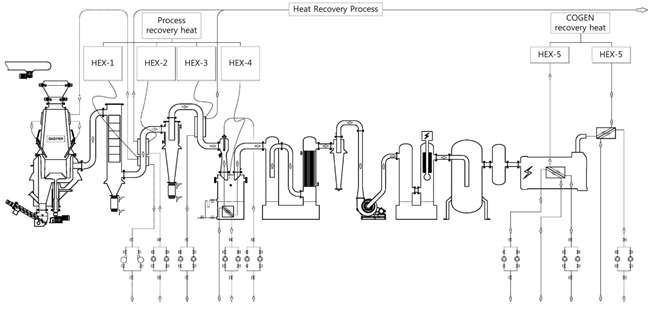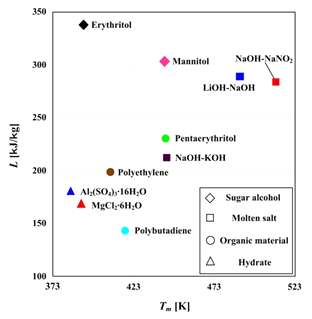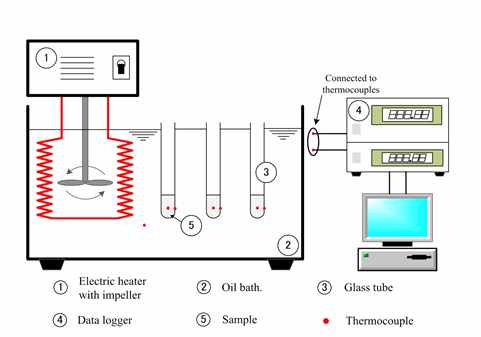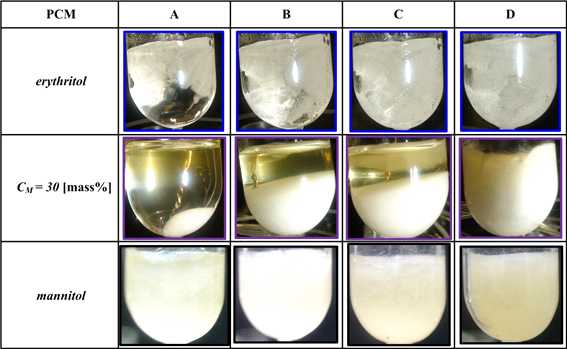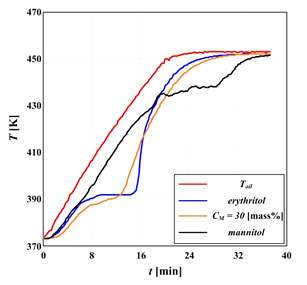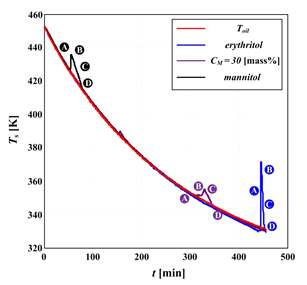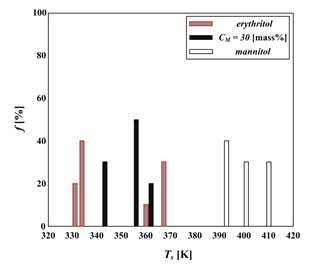
Fundamental study on development of latent heat storage material for waste heat recovery of biomass gasification
Recently, latent heat thermal energy storage system (LHTES) has gained attention in order to utilize middle temperature (373~573 K) waste heat from biomass gasification. This paper has investigated thermo-physical properties of erythritol [CH2OHCHOH CHOHCH2OH], mannitol [CH2OH (CHOH)4CH2OH] and their compounds as phase change materials (PCMs). The differential scanning calorimetry (DSC) was applied to measure the melting point and latent heat of these PCMs. Also the melting and solidification characteristics of these PCMs were observed in a glass tube with a digital camera. In the DSC measurement, when the amount of mannitol content was more than 40 mass%, the melting point of these compounds show two melting points. The experimental results showed that the velocity of melting and solidification were different for every mixture ratio of compounds. These compounds had the super-cooling phenomenon during the solidification process.
Keywords:
Biomass, Gasification, Waste heat, Latent heat, Phase Change Materials, Mannitol, Erythritol1. Introduction
In recent years, the increase in global energy consumption has led to rising pollution levels.
Fossil fuels such as coal and oil significantly emit NOx, SOx and CO2 upon combustion, which subsequently cause acid rain, ozone depletion, global warming and their after effects such as rising sea levels [1]. Thus, it is necessary to find a renewable resource for reducing the gaseous emissions from fossil fuels thereby bringing down the costs of mitigating these pollutants.
Biomass is a major renewable, sustainable and environmental-friendly energy source, which can convert carbon to solid, liquid and gaseous products through different processes such as gasification. It is ranked fourth among the primary energy sources such as coal, oil and natural gas and currently caters for about 14% of the world’s total energy consumption [2]. Biomass is constituted of a broad range of organic materials derived from plants and recently living organisms.
The general chemical formula for biomass is CxHyOz [3]. Biomass can generate electricity, heat, vehicle fuel and can also produce the feedstock for several chemical industries. Generally, there are four types of biomass: woody plant, herbaceous plants, aquatic plants and manures [3]-[5]. Most of the researchers have studied the woody and herbaceous plants because they have lower moisture content than other species. The key differences in the properties of biomass in comparison with coal and coke are [1][4][6][7]:
1. Greater moisture content.
2. Lower heating value.
3. Higher volatile matter.
4. Higher reactivity of both biomass and its resulting char, due to holocellulose and lignin contents of biomass with weaker bonds.
5. Lower ash.
6. Higher alkali content (especially the herbaceous type), which plays a key role in thermo chemical processes.
7. Lower bulk density thus making the transportation and storage costs higher.
8. Greater oxygen and hydrogen content.
9. Lower sulfur and nitrogen content.
Also, biomass energy utilization has gained particular interest in recent years due to the progressive depletion of conventional fossil fuels, that calls for an increased use of renewable energy sources. Moreover, the moderate sulphur and greenhouse gas emissions associated with the use of biomass for energy production respond to the growing pressure of government policies about achievement of better environmental sustainability of power generation processes in terms of air pollution control [8]. Biomass may be used to meet a wide variety of energy needs, including generating electricity, providing process heat for industrial facilities, heating homes and fuelling vehicles. The conversion of biomass to such useful forms of energy, also called bio-energy, can be achieved using a number of different technological solutions that can be separated into two basic categories, namely thermochemical processes and biochemical/biological processes.
Figure 1 shows biomass gasification process. In this process, waste heat is generated from gasification, refining equipment etc. Thermal energy storage system is required in order to store waste heat.
The stored energy by thermal energy storage system is utilized for heating of residential and industrial buildings, etc.
Some studies [9]-[13] on thermo-physical properties as PCMs are concentrated in finding and developing the materials of latent heat thermal energy storage system (LHTES).
The present paper is concerned with PCMs of organic material at temperature region of biomass gasification process waste heat source about 373~523K, which are investigated the melting and solidification characteristics.
The goal of this study is selecting the PCMs at temperature region of biomass gasification process waste heat source (373~523K) by clarify the possibility of optimum mixture ratios
2. The sample of PCMs
The middle temperature LHTES approach can reduce the energy storage container, since the energy density is large. We have to choose the PCMs which can be utilized in temperature range of biomass gasification process waste heat about 373~523 K.
In order to find the best material in the experiment, we screened the relationship between latent heat and melting point.
The distribution of materials with melting point in the range 373~523 K are shown in Figure 2, which describes the latent heat and melting point for molten salts, organic materials and inorganic material [14]. Molten salt have big corrosiveness with other material. If it is increased the heat to hydrate, it is separated from water.
From Figure 2, it is clear that the optimum material is generally known as erythritol and mannitol with melting point range 373~523 K. Among phase change materials of organic material, erythritol and mannitol of sugar alcohol have specially high latent heat. In addition, erythritol and mannitol are environmentally friendly materials, non-toxic and non-flammable. The selected thermo-physical properities of the PCMs are given in Table 1.
In this study, erythritol with purity of more than 99.5% (Mitsubishi Chemical Corp.) and mannitol with purity of more than 99.0% (Tokyo chemical industry Corp.) were used as PCM samples.
3. Experimental apparatus
In this study, two measuring equipments were used to investigate the melting and solidification behavior of erythritol, mannitol and their compounds as phase change materials (PCMs). One of two measuring equipment is the differential scanning calorimetry (DSC; Reigaku, Thermo Plus2/DSC8270) which was used to measure the melting point and latent heat of these PCMs. Other equipment is schematically shown in Figure 2. This apparatus mainly consists of a constant temperature oil bath (TOMAS, T-301), glass tubes (25ø ×200 mm), a digital camera, and a data logger.
The melting process was prepared as the initial condition of oil bath at 373 K. To melt these PCMs in the glasstubes, the oil was heated until its temperature increased to 453K (4 K/min) using an electric heater with an impeller. The solidification period started directly after the completion of the melting period. The electric heater of oil bath was tuned off and the oil bath was naturally cooling (0.13 K/min) until these PCMs in the glass tube were solidified. During this period, temperature variation of these PCMs and surrounding oil bath were measured by thermocouples of K-type (0.1 mm). The measured temperature data were recorded by a data logger in 13-sec intervals. And these PCMs set in the glass tubes were observed using a digital camera.
4. Results and discussion
4.1 DSC analysis of erythritol, mannitol and their compounds
Figure 4 indicates the results of DSC analysis of melting temperature (Tm) and latent heat (L) of erythritol (mannitol contents,CM = 0 mass%), mannitol (CM = 100 mass%) and their compounds. From Figure 4, at mannitol contents from 50 to 90 mass%, these compounds have two melting points. The erythritol-mannitol mixtures with the mannitol contents between 10 and 30 mass% have melting temperatures with from 394 to 396 K, which is applied to latent heat storage for heating system. In this range, the addition from 10, 20, 30 mass% mannitol resulted that melting begins at 396.5, 396.4, 394.8 K, respectively. This phenomenon is explained as follows. In general, it is reported that the adjustment of the melting point can be achieved by disrupting the crystal arrangement and weakening the intermolecular interactions by adding impurities [17]. The compounds of this range has high latent heat further than other heat storage materials in the medium.
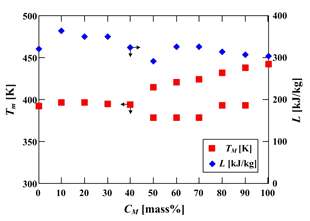
DSC analysis results on latent heats, and melting temperature of erythritol mixed with mannitol at various ratios
temperature region (373~523 K), which has latent heat of 362.5, 349.8, 349.2 kJ/kg, respectively. However, if mannitol is added over 50 mass% to erythritol, the mixture compounds not recommended as promising candidate as PCMs the medium temperature region. This is caused by the heat storage with two melting point, that is smaller than heat storage with one melting point at mannitol content from 10 to 30 mass%.
4.2 Melting behavior of erythritol, mannitol and their compounds during melting process
Figure 5 shows the results of temperature on melting process of erythritol, mannitol and erythritol mixed with mannitol at 30 mass% in the oil bath. From Figure 6, we know that a latent heat region of 30 mass% mannitol content is shorter than a latent heat region of erythritol and increased with gentle slope. The reason of this phenomenon is considered from the effect of mannitol characteristic. And these PCMs and their compound are a small discrepancy between the results of DSC analysis and the results of experiment, which may be due to the fact that the amount of PCMs and their compounds used in the experimental study (5 g) is more than the amount used (5 mg) for the DSC analysis. Therefore, the measurement point of PCMs for small amount is much better compare with those for large amounts of PCMs.
4.3 Solidification behavior of erythritol, mannitol and their compounds during solidification process
Figure 6 shows the temperatures of solidification process of erythritol, mannitol and erythritol mixed with mannitol at 30 mass% in the oil bath, it is clearly known that erythritol, mannitol and their compound have the phenomenon of super-cooling. For 30 mass% mannitol content, the degrees of super-cooling were about 20K. These results show that 30 mass% mannitol contents has smaller degree of super-cooling than with erythrtiol (60 K).
Figure 7 shows the results of visual observations on the phenomena of super-cooling during the solidification process of erythritol, mannitol and erythritol mixed with mannitol at 30 mass%. The process of solidification A, B, C, D shown in Figure 7 corresponds to that indicated as in Figure 6. Visual observation of pure erythritol shows that solidification began at the upper surface in interface of PCMs. However, in the case of mannitol it shows that solidification of overall the glass tube with mannitol. The solidification began at about 350K at the bottom surface of 30 mass% mannitol contents. After the completion of its solidification, erythritol was solidified at about 354 K at the upper surface in interface of that and complete at about 345 K.
Figure 8 shows distribution of temperatures of the solidification. During 10 cycles of this experimental study, solidification completion regions indicates that 30 mass% mannitol contents, mannitol has 343~334 K, 393~410 K, respectively. Howerer, erythritol has 331~334 K and 361~367 K.
5. Conclusion
In the present study is proposed to use erythritol, mannitol and their compounds of organic material at middle temperature about 373~573 K, which are investigated from the melting and solidification characteristics. When selected PCMs mixed, these compounds are also investigated optimum mixture ratio. The acquired main conclusions are summarized as follows.
Through the comparison of the heat storage temperature and energy density of PCMs, sugar alcohol system PCMs was indicated effective.
At mannitol contents from 50 to 90 mass%, the melting points of these compounds have two melting points.
If the mixture of erythritol & 30 mass% of mannitol may control the super-cooling phenomenon, it can be used as PCM in LHTES, which has relatively low degrees of super-cooling. In this study, mannitol, erythritol and their compounds as PCMs had the phenomenon of super-cooling, which will be studied for relaxation of super-cooling in the subject of next investigations.
Acknowledgments
This paper is extended and updated from the short version that appeared in the Proceedings of the International symposium on Marine Engineering and Technology (ISMT 2013), held at BEXCO, Busan, Korea on October 23-25, 2013.
This research was utilized the obtained result from project with Ministry of Knowledge Economy [Project No. 12B12945450] of Korea.
References
-
A. Demirbas, “Sustainable cofiring of biomass with coal”, Energy Convers Manage, 44(9), p1465-1479, (2003).
[https://doi.org/10.1016/S0196-8904(02)00144-9]

-
ZABZ Alauddin, P. Lahijani, M. Mohammadi, and AR. Mohamed, “Gasification of lignocellulosic biomass in fluidized beds for renewable energy development: A review”, Renewable Sustainable Energy Reviews, 14(9), p2852-2862, (2010).
[https://doi.org/10.1016/j.rser.2010.07.026]

-
V. Kirubakaran, V. Sivaramakrishnan, R. Nalini, T. Sekar, M. Premalatha, and P. Subramanian, “A review on gasification of biomass”, Renewable Sustainable Energy Reviews, 13(1), p179-186, (2009).
[https://doi.org/10.1016/j.rser.2007.07.001]

-
P. McKendry, “Energy production from biomass (Part 1): Overview of biomass”, Bioresour. Technol, 83(1), p37-46, (2002).
[https://doi.org/10.1016/S0960-8524(01)00118-3]

-
C. Highman, M. Van der Burgt, Gasification. 1st ed, USA: Gulf Professional, (2003).
[https://doi.org/10.1016/B978-0-12-373611-6.00011-2]

-
A. Valero, and S. Uso´n, “Oxy-co-gasification of coal and biomass in an integrated gasification combined cycle (IGCC) power plant”, Energy, 31(10-11), p1643-1655, (2006).
[https://doi.org/10.1016/j.energy.2006.01.005]

-
M. Lapuerta, JJ. Herna´ndez, A. Pazo, and J. Lopez, “Gasification and co-gasification of biomass wastes: effect of the biomass origin and the gasifier operating conditions”, Fuel Process Technol, 89(9), p828-837, (2008).
[https://doi.org/10.1016/j.fuproc.2008.02.001]

-
A. Demirbas, “Biomass resource facilities and biomass conversion processing for fuels and chemicals”, Energy Conversion and Management, 42(11), p1357-1378, (2001).
[https://doi.org/10.1016/S0196-8904(00)00137-0]

- H. Inaba, Z. Li, A. Horibe, and K. Ozaki, “Heat release characteristics of latent heat storage vessel packed with surface crosslinked form-stablilzed polyethylene pellets”, Proceedings of the 34th National Heat Transfer Symposium of Japan, p707-708, (1997).
-
G. Baran, and A. Sari, “Phase change and heat transfer characteristics of a eutectic mixture of palmitic and stearic acids as PCM in a latent heat storage system”, Energy Conversion and Management, 44(20), p3227-3246, (2003).
[https://doi.org/10.1016/S0196-8904(03)00104-3]

-
E. P. Ona, X. Zhang, K. Kyaw, F. Watanabe, H. Matsuda, H. Kakiuchi, M. Yabe, and S. Chihara, “Relaxation of supercooling of erythritol for latent heat storage”, Journal of Chemical Engineering of Japan, 34(3), p376-382, (2001).
[https://doi.org/10.1252/jcej.34.376]

- M. K. Erwin, P. Ona, F. Watanabe, H. Matsuda, and H. Kakiuchi, “Studies on phase change characteristics of binary mixtures of erythritol and MgCl2•6H2O”, Journal of Chemical Engineering of Japan, 40(1), p80-84, (2007).
-
F. Agyenim, N. Hewitt, P. Eames, and M. Smyth, “A review of materials, heat transfer and phase change problem formulation for latent heat thermal energy storage systems (LHTESS)”, Renewable and Sustainable Energy Reviews, 14(2), p615-628, (2010).
[https://doi.org/10.1016/j.rser.2009.10.015]

- Japan Society of Thermophysical Properties, Thermophysical Properties Handbook, p119-124, (1990).
- Mitsubishi Chemical Engineering, The Document of Heat Storage Division, (1999).
- A. Hoshi, and T. S. Saitoh, “A study of solar steam accumulator with high temperature latent heat thermal energy storage (1st Report; High melting point phase change material)”, Journal of Japan Solar Energy Society, 27(5), p34-40, (2001).
- H. Hidaka, M. Yamazaki, M. Yabe, H. Kakiuchi, E. P. Ona, Y. Kojima, and H. Matsuda, “New PCMs prepared from erythritol-polyalcohols mixtures for latent heat storage between 80 and 100˚C”, Journal of Chemical Engineering of Japan, 37(9), p1155-1162, (2004).
